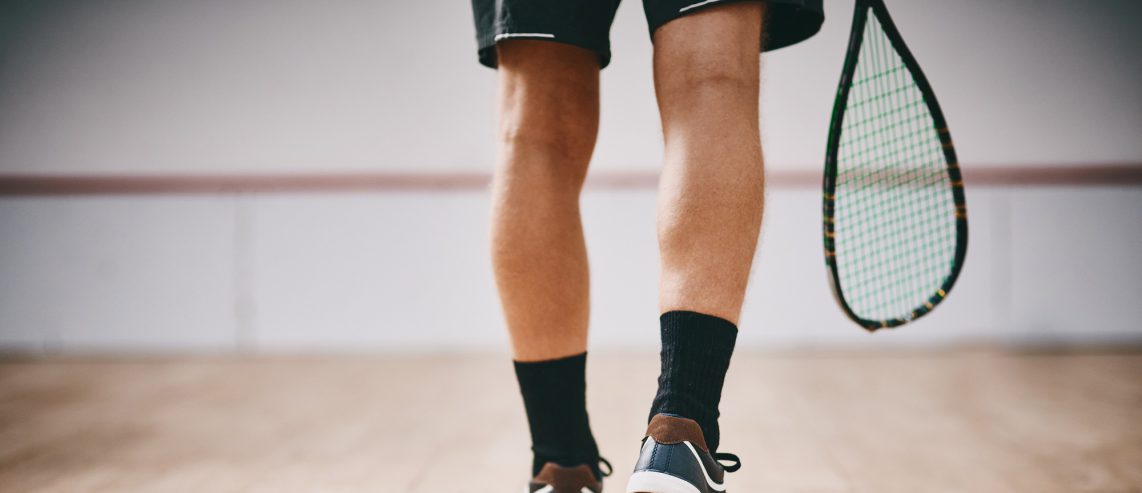There were times during the 2024 Pittsburgh Open when Craig Mauro, MD, couldn’t take his eyes off the squash players. Granted, as one of the doctors overseeing medical care at the tournament, it was his job.
That’s because UPMC provided sports medicine coverage for the tournament. The competition was part of the Professional Squash Association (PSA).
It featured some of the best male squash players in the world. Along with Mounif “Moe” Rifkah, MD, Dr. Mauro was on hand to tend to any squash injuries.
An orthopaedic surgeon at UPMC, Dr. Mauro is also a team physician for the Pittsburgh Steelers. That means he sees many high-caliber athletes. “But the squash players’ intense cardiac output and amazing precision was almost like watching a dance,” Dr. Mauro says.
If you haven’t caught onto the squash craze, it’s time to learn more about this sport. This includes the benefits of playing squash, common squash injuries, and injury prevention strategies.
Never Miss a Beat!
Subscribe to Our HealthBeat Newsletter!
Thank you for subscribing!
You can now select the specific newsletters you'd like to receive.
You are already subscribed.
Subscribe to more newsletters in our email preference center.
Sorry, an error occurred. Please try again later.
Get Healthy Tips Sent to Your Phone!
Squash Is Gaining Popularity in Pittsburgh
The way squash players move and how they conserve energy and turn it into power is a fascinating study in biomechanics, Dr. Mauro says. As a novice squash player, Dr. Mauro feels inspired to keep practicing the sport. “I’m not very good, but it’s a great workout,” he says.
He hopes others in Pittsburgh might show interest in trying squash mainly because the sport has grown in popularity. “It’s a fun sport to take up because it forces you to train in different ways,” he says.
With Steel City Squash Center opening soon, even more opportunities may arise. (Steel City Squash is a program for students, but the new center will serve many purposes.) “There’s a lot of energy around squash in Pittsburgh,” he says.
But with that comes athletic injuries. Dr. Mauro treats many squash players, from inexperienced young people to a U.S. Masters squash champion in the 60 and up division.
Whether you’re new to the game or have been playing for years, it’s good to understand some of the common squash injuries. Dr. Mauro also has advice about what types of training can help to prevent them.
What Are the Most Common Squash Injuries?
“Because of the movements and the nature of the sport, there are a number of different areas of concern,” Dr. Mauro says. In squash, players tend to deal with two types of injuries: traumatic and repetitive.
Traumatic injuries on the squash court
In squash, the lower extremities are most at risk for traumatic injuries. That means your ankles, Achilles tendon, and knees. “I’ve seen a lot of ACL tears in squash players,” Dr. Mauro says.
This is because of the nature of the movement and the court itself. If you’ve watched a squash match or played one yourself, you know it moves quickly. And players’ movements are often unpredictable, with a lot of twists and turns on a dime.
When you combine that with a sticky floor, it’s easy to twist an ankle or a knee. The squash court surface is like a basketball court surface. “It’s good for being able to stop and start suddenly, but your foot can get stuck,” he says.
Repetitive motion injuries in squash
When it comes to squash injuries from overuse, it’s usually the upper extremities. “The shoulder is in high demand during squash,” Dr. Mauro says. “The squash swing takes very specific mechanics.”
If your mechanics are just a little off, you must overuse the shoulder, which puts your joint at risk. “We see a lot of rotator cuff tendonitis, biceps tendonitis, and tennis elbow with squash players,” he adds. These are all repetitive motion injuries.
How you hold the squash racket matters, too, he says. “In squash, you swing with a more extended wrist, which stresses the wrist extensors. “It’s why squash players can wind up with wrist sprains.
Injury Prevention for Squash Players
“I tell my squash athletes to make sure they are doing their homework,” Dr. Mauro says. That means exercises and cross-training to help prevent traumatic and overuse injuries.
He suggests changing up your movement patterns to work on agility, which can help prevent those sudden knee and ankle twists. “It’s not enough just to do cardio, distance running, or the elliptical,” he says. Though those movements are great for building strength and endurance, they don’t force your body off balance.
He tells his athletes to do plyometric moves, especially off-balance ones (jumping and landing on one foot, for example). You should also train movements that mimic the movements during a squash game. That could mean lunging forward, backward, and sideways, for instance.
Running backward is another excellent exercise. “You need to try to do things with quick feet and explosive movements.”
As for preventing overuse injuries, much of that has to do with technique. “It’s all about the mechanics of your swing and maintaining the scapular muscles.”
As for which specific exercises can help you with that maintenance, Dr. Mauro suggests working with a physical therapist. “I’ll often give some general guidance, like ‘you need to work on shoulder blade control,'” he says. “But a physical therapist can really work with you on the specific exercises you need to do.”
Benefits of Playing Squash
If you’re new to squash, don’t let the discussion of injuries intimidate you. And don’t think you’re too old to learn something new, either.
As we age, moving our bodies in different ways becomes even more critical. “As we age, we can’t only just do cardio,” Dr. Mauro says. “We need a combination of cardio, strength, and plyometrics, including explosive movements.”
The great thing about squash is that it gives you all these things. It’s constant cardio, but you also have to move your body in different ways. It also trains hand-eye coordination and improves balance. And
And it’s fun, Dr. Mauro says. There’s never been a better time to become a squash fan — or a squash player.
About Sports Medicine
An athletic lifestyle carries the potential for injury. Whether you’re an elite athlete or a weekend warrior, UPMC Sports Medicine can help. If you are looking to prevent, treat, or rehabilitate a sports injury, our multidisciplinary team of experts can help you get back into the game. If you are seeking to improve your athletic performance, we can work with you to meet your goals. We serve athletes and active people of all ages and experience levels. Our goal is to help you keep doing what you love. Visit our website to find a specialist near you.

